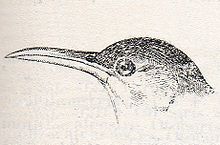- Dupont's Lark
-
Dupont's Lark 
Conservation status Scientific classification Kingdom: Animalia Phylum: Chordata Class: Aves Order: Passeriformes Family: Alaudidae Genus: Chersophilus
Sharpe, 1890Species: C. duponti Binomial name Chersophilus duponti
(Vieillot, 1820)The Dupont's Lark (Chersophilus duponti) is the only lark in the genus Chersophilus.
Contents
Description
Like most other larks, Dupont's Lark is an undistinguished looking species on the ground. It is 17–18 cm long, slim, with a long neck, long legs and a fine slightly curved bill. It has a thin pale crown stripe and a dark-streaked breast.
Taxonomy and nomenclature
Dupont's Lark was originally described by Louis Jean Pierre Vieillot in 1820.[2] This bird was named after the French naturalist Leonard Puech Dupont, who was the first to collect a specimen.[citation needed]
There are two races. C. d. duponti of Europe and northwest Africa is mainly brown-grey above and pale below. C. d. margaritae, which occupies most of the rest of the African range, has rufous upperparts.
Distribution
It breeds across much of north Africa, from Algeria to Egypt, and in Spain and France.[1] It is a non-migratory resident.
Behaviour
This is a very shy species, which runs for cover when disturbed.
Breeding
This is a bird of open sandy semi-desert or steppe with some grass. Its nest is on the ground, with 3-4 eggs being laid. Its food is seeds and insects.
Vocalisations
Its song is a nasal whistle, given mainly at dawn and dusk or at night.
References
- ^ a b "Chersophilus duponti". IUCN Red List of Threatened Species. Version 2011.2. International Union for Conservation of Nature. 2008. http://www.iucnredlist.org/apps/redlist/details/106008168. Retrieved 17 November 2011.
- ^ Vieillot, Louis Jean Pierre (1820) Faune française, ou Histoire naturelle, générale et particulière des animaux qui se trouvent en France, constamment ou passagèrement, à la surface du sol, dans les eaux qui le baignent, et dans le lit, pages 173-174 (in French)
External links

This Alaudidae-related article is a stub. You can help Wikipedia by expanding it.

